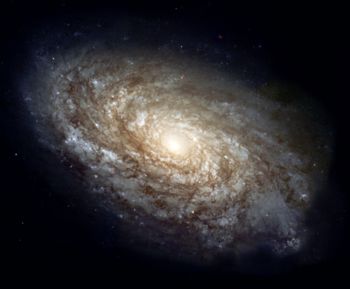Galaxy
 From Conservapedia
From Conservapedia 
A galaxy is a massive ensemble of tens of millions to trillions of stars some with associated planets and planetary systems, all interacting through the gravitational force, orbiting around a common center.[1] The observable universe contains hundreds of billions of galaxies. Some scholars theorize that at the center of every galaxy lies a super massive black hole. The Sun, the Earth and our Solar System are in the Milky Way galaxy.
Age Dispute[edit]
Many scientists assert that materialistic explanations of galaxy formation are unsupportable and counter evidence.[2][3][4][5][6] In 1988, fifty cosmologists attended a conference which focused on galaxy formation. After summarizing the observational data, two of the most respected scientists estimated the probability that any existing theory on galaxy formation is correct was about 1 out of 100.[7] In 1999, J. Bland-Hawthorn wrote in the science journal Nature the following:
"In 1977, Stephen Weinberg observed that "the theory of the formation of galaxies is one of the great outstanding problems of astrophysics, a problem that today seems far from solution". Although the past two decades have seen considerable progress, many questions remain." [8]
In 2001, Cristina Chiappini wrote regarding the Milky Way galaxy the following:
. . . it is an elegant structure that shows both order and complexity. . . . The end product is especially remarkable in the light of what is believed to be the starting point: nebulous blobs of gas. How the universe made the Milky Way from such simple beginnings is not altogether clear. - Cristina Chiappini, "The Formation and Evolution of the Milky Way," American Scientist (vol. 89, Nov./Dec. 2001), p. 506.[9]
The Institute for Creation Research wrote the following regarding a 2005 article in Science News the following:
A strange cartoon graced the cover of Science News last fall (10/08/2005) that serves as a symbol for a whole class of problems for evolutionary astronomers. It showed a star-shaped old man in a stellar maternity ward. With its title, "Crisis in the Cosmos? Galaxy-formation theory is in peril," the article exposed a running theme in astronomy: as far back as we look, stars and galaxies appear mature.
"Imagine peering into a nursery and seeing, among the cooing babies, a few that look like grown men," Ron Cowen quipped. "That's the startling situation that astronomers have stumbled upon as they've looked deep into space and thus back to a time when newborn galaxies filled the cosmos."....
These findings corroborate a January 8, 2002, NASA press release that was considered astonishing at the time: based on Hubble surveys, "the grand finale came first" in stellar and galactic evolution. As far back as telescopes look, they see mature creation, not evolution.[10]
Young earth creationists also cite the following:
“In its simplest form, the big bang scenario doesn’t look like a good way to make galaxies. It allows too little time for the force of gravity by itself to gather ordinary matter—neutrons, protons and electrons—into the patterns of galaxies seen today. Yet the theory survives for want of a better idea.” Ivars Peterson, Science News, "Seeding the universe: how did matter assemble itself into the giant filaments, clusters, bubbles and walls of galaxies that now fill the universe?" March 24, 1990, p. 184.[7][11]
“It [the Great Wall, composed of tens of thousands of galaxies] is far too large and too massive to have formed by the mutual gravitational attraction of its member galaxies.” M. Mitchell Waldrop, “Astronomers Go Up Against the Great Wall,” Science, Vol. 246, 17 November 1989, p. 885. (See also Margaret J. Geller and John P. Huchra, “Mapping the Universe,” Science, Vol. 246, 17 November 1989, pp. 897–903).[7]
References[edit]
- ↑ Wile, Dr. Jay L. Exploring Creation With Physical Science. Apologia Educational Ministries, Inc. 1999, 2000
- ↑ In the Beginning: Compelling Evidence for Creation and the Flood - 62. Galaxies. creationscience.com (2019-09-01). Retrieved on 2019-09-15.
- ↑ Andrew Rigg (2004-06-01). Young Galaxies Too Old for the Big Bang. answersingenesis.org. Retrieved on 2019-09-15.
- ↑ Rod Bernitt (August 2000). Phoenix Galaxy stars explode stellar evolution theory. creation.com. Retrieved on 2019-09-15.
- ↑ Andrew Rigg (2004-12-01). Galaxy Games. anwersingenesis.org. Retrieved on 2019-09-15.
- ↑ Andy McIntosh and Carl Wieland (March 2003). ‘Early’ galaxies don’t fit!. creation.com. Retrieved on 2019-09-15.
- ↑ 7.0 7.1 7.2 In the Beginning: Compelling Evidence for Creation and the Flood - 60. Fast Binaries. creationscience.com. Retrieved on 2019-09-15.
- ↑ Bland-Hawthorn, J. (1999). "Clues to galaxy formation". Nature 400: 220-221. doi:10.1038/22230.
- ↑ Henry M. Morris (2002-07-01). What Astronomers Don't Know. icr.org. Retrieved on 2019-09-15.
- ↑ David F. Coppedge (2006-10-01). Mature at Birth: Universe Discredits Evolution. Retrieved on 2019-09-15.
- ↑ Seeding the universe: how did matter assemble itself into the giant filaments, clusters, bubbles and walls of galaxies that now fill the universe?. Archived from the original on 2019-09-15.
| ||||||||||||||||||||||||||||||||||||||||||||||||||||||||||||||||||||||||||||||||||||||
Categories: [Astronomy] [Galaxies]
↧ Download as ZWI file | Last modified: 03/01/2023 11:35:41 | 89 views
☰ Source: https://www.conservapedia.com/Galaxy | License: CC BY-SA 3.0
 ZWI signed:
ZWI signed: KSF
KSF